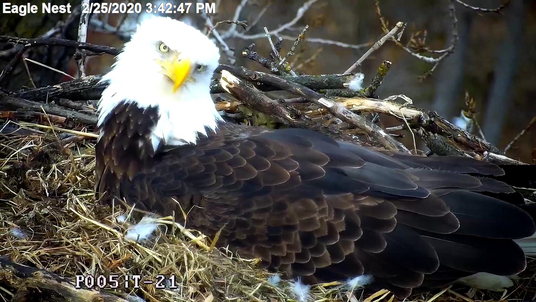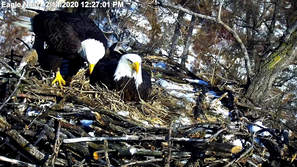|
|
|
February 28, 2020

in·nate (i-ˈnāt) adjective 1. Existing in, belonging to, or determined by factors present in an individual from birth.
The natural world is filled with examples of mind-boggling innate talents. Like how do birds know where to migrate to? They were born that way. How do animals know which berries are good to eat? That knowledge is built in. How do eagles know they need to roll the eggs around, or not crush them? Its innate - and our favorite eagles show off their innate abilities every day(not like they have much choice). The cooperation between the two of them is both educational and fun to watch -- adding sticks and grasses to the nest as needed, curling up their talons when stepping close to the eggs, gently wiggling their bodies to pull the eggs next to their warm skin. These innate abilities exist to promote successful hatching of the eggs. The parents are tightly focused on doing everything they can to make sure the eggs hatch, a key step in their overall goal of reproductive success.

Eagles, like most birds, lay multiple eggs (called a clutch). The reason for multiple eggs is so the species can survive and, if the whole clutch hatches - thrive.
If one or two of the eggs don't hatch, or the chicks don't survive, there will be one or two left to carry the genetic material forward. Nature's focus is on survival of the species -- not the individual.
We're all excited and hopeful for a new brood of eaglets after two years of waiting. We've missed the fuzzy, wobbly heads of the clumsy chicks. But we need to be emotionally prepared in case things don't turn out the way we'd like.
Eagle chicks are altricial - which means they're completely dependent upon their parents for survival. The parents provide warmth, food, protection from predators, and shelter from Minnesota's harsh weather. The first few days after hatching is when chicks are the most vulnerable. Let's all keep our fingers crossed, and hope for the best!
|

We've come a long way, baby!
Since our first year of peering into the private lives of bald eagles in 2013, we've dealt with numerous challenges with each and every aspect of running a successful EagleCam. The camera, livestreaming ability, hardware, software, the sound, and the human capacity to keep all of this running at a high-level -- each has had issues at one point or another.
The small crew that keeps open this live window into the exciting world of nature is committed to doing all that we can to provide a quality experience for viewers from around the world. We truly appreciate all of your praise and support -- along with your patience. When something isn't working, you can be assured we're doing our best to get it back up and running as quickly as possible!
|
|
|
|
|
Minnesota Nongame Wildlife Program
DNR’s Nongame Wildlife Program helps preserve and protect thousands of Minnesota wildlife species, some of them threatened or endangered. The program is supported largely through voluntary donations, either directly or by designating an amount to donate on your Minnesota individual income tax form (look for the loon). Donations help us restore habitats, conduct crucial surveys and monitoring, engage in outreach and education (like our Eagle and Falcon cams), and complete other important projects. Visit mndnr.gov/nongame to learn more.
|
|